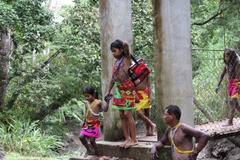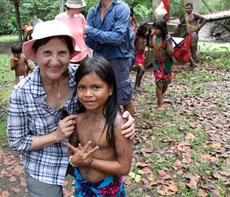The greeting party were from an Embera village. Check them out on wikipedia as there is an interesting article about them. Here is another article about them from a travel site (thanks to Vicki P for point me at the article). I have mixed emotions about the second article. Maybe I am too naive.
The villagers are indigenous Panamanians. Apparently they are genetically a mix of the original Panamanians; African slaves, and Spaniards. The village was founded in the mid-1960s. It has about 300 people living in 42 houses. They are primarily farmers growing corn and rice which they both eat and sell as a cash crop. They also make some money from selling crafts to visitors like us. However, and this is amazing, they rarely have visitors. There is a Peace Corps volunteer living and working there and he told us that in the the last 10 months, he has seen 5 groups of visitors. I was expecting something like an Indian reservation as we have in the US with lots of tourists and visitors. This was not even close to that. These people rarely saw outsiders. Given the difficulty of getting there--the issues with the tide, a long boat ride (there are no roads), and a 40 minute walk at low tide, it is understandable.

Because the tide was still near its low point when we arrived, we had to get off the boat at the river and walk to the village. The first half or so was over a board walk that was sturdy enough, but not up to OSHA standard by any stretch. The railing you see is useful for a balance check, but you would NOT want to put much weight on it. (Caroline, Jeanne and Jon) In high tide there would be water under that board walk. At the time, it was just muddy. We wondered why there were not mosquitoes. It was humid, wet, and there was plenty of standing water. But, none of were complaining!

At the end of the board walk was a bridge that was funded by USAID according to the sign on the side.
The children were happy to help as you can see from this picture of the girl carrying one of the soft thermoses that held water for our group. They were also happy to pose for pictures and were fascinated to see them on our cameras. Notice the peace sign on the girl with Caroline.



Most of the men and all of the boys were wearing brightly colored loin clothes that weren't hiding much. In discussions with our guides we learned that on a normal day they wear shorts of some kind. They were anxious to show us their culture and everybody was essentially dressed up in their Sunday best for the visitors. (Which meant very little clothing) Notice the man on the left in the picture, you can see the body paint that most of them have in varying degrees. Besides being decorative, they think the paint repels insects. Essentially all of them had some paint on their bodies. It lasts a week or two before it comes off. Many of our party had some applied to their arms.

All of the women were wearing a wrap around skirt of brightly colored fabric. They wore no clothes above the waist but many had elaborate necklaces or beads. Many of the men and children had beads on around their necks as well. Caroline and Jeannie bought some of the material, but that is as far as they got in "going native".
Continued in the next post...
